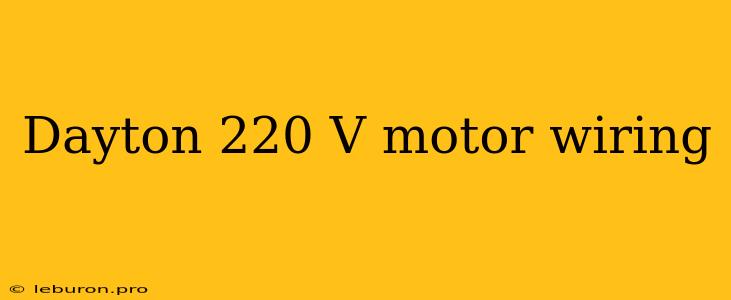Understanding Dayton 220V Motor Wiring: A Comprehensive Guide
Dayton 220V motors are a staple in various applications, from industrial machinery to home workshops. Their robust performance and reliability make them a popular choice for a wide range of tasks. However, understanding the intricacies of Dayton 220V motor wiring can be daunting for those unfamiliar with electrical systems. This guide aims to demystify the process, providing a step-by-step explanation to ensure safe and efficient operation.
Essential Components of Dayton 220V Motor Wiring
Before diving into the wiring procedure, it's crucial to familiarize yourself with the key components involved:
1. Motor Terminal Box:
This box houses the motor's connection points, typically labeled with letters like L1, L2, T1, and T2. The labels correspond to the different phases and windings of the motor.
2. Electrical Supply:
A 220V power supply is required to operate the motor. It is essential to ensure your electrical system is compatible and can handle the motor's wattage.
3. Wiring Diagram:
Every Dayton 220V motor comes with a wiring diagram. This diagram is your roadmap, showing the correct connection points for each wire. It is crucial to refer to the specific diagram for your model before starting any wiring.
4. Wire Types:
Use appropriate wire gauge and insulation based on the motor's amperage rating and operating environment. Consult the wiring diagram for specific recommendations.
5. Electrical Tools:
You'll need basic electrical tools like wire strippers, a voltage tester, and a screwdriver with insulated handles.
Steps for Dayton 220V Motor Wiring:
1. Disconnect Power:
Always disconnect the power supply to your electrical system before working on any wiring. This is essential for safety and prevents accidental shocks.
2. Identify Motor Terminals:
Locate the terminal box on your Dayton 220V motor. The terminals will be clearly labeled.
3. Reference Wiring Diagram:
Carefully study the wiring diagram provided with your specific motor. It will show the correct connections between the motor terminals, the power supply, and any external components.
4. Prepare Wires:
Strip the insulation off the ends of your wires using a wire stripper. Ensure the exposed wire is clean and free of any damage.
5. Connect Wires to Terminals:
Following the wiring diagram, carefully connect the wires to the corresponding terminals in the motor's terminal box. Secure the connections with the appropriate screws or terminal blocks.
6. Double Check Connections:
Before applying power, thoroughly double-check all wire connections. Ensure each wire is securely connected to the correct terminal and that no wires are loose or exposed.
7. Apply Power:
After verifying all connections, cautiously apply power to the motor. Observe the motor for proper operation and listen for any unusual sounds or vibrations.
8. Test Motor Operation:
Run the motor for a short period to ensure it operates as intended. If the motor runs smoothly and without any issues, you have successfully wired it.
9. Secure Wiring:
After testing the motor, secure all wires to prevent accidental disconnections. Ensure the terminal box is properly closed and that the wiring does not pose any safety hazards.
Important Safety Precautions for Dayton 220V Motor Wiring:
-
Always wear proper safety gear: This includes safety glasses, gloves, and closed-toe footwear.
-
Never work on live electrical systems: Always disconnect power before working on any wiring.
-
Be mindful of potential hazards: Be aware of the dangers of electricity and avoid contact with live wires.
-
Follow manufacturer instructions: Always refer to the wiring diagram provided by Dayton for your specific motor model.
-
Seek professional help if needed: If you are not comfortable or experienced with electrical work, consult a qualified electrician.
Conclusion:
Understanding Dayton 220V motor wiring is crucial for ensuring safe and efficient operation. By following the steps outlined in this guide, you can confidently connect your motor and get it up and running. Remember, safety should always be your top priority. If you have any doubts or concerns, consult the manufacturer's documentation or seek assistance from a qualified electrician.
